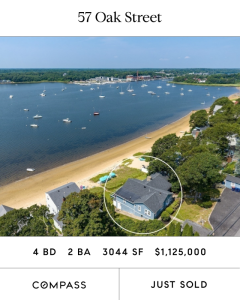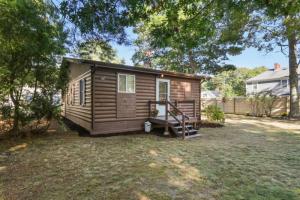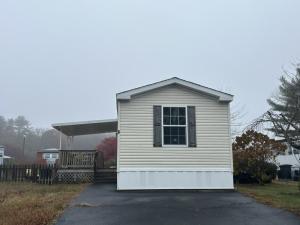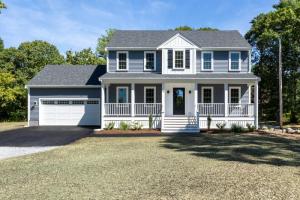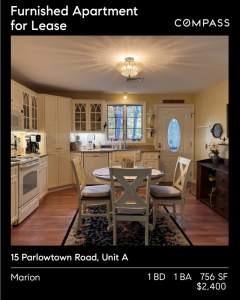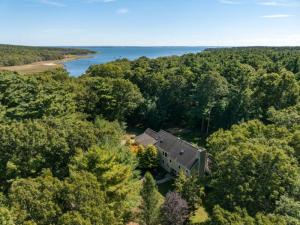Take a peek inside the studios, hear their stories
Event Date
 Dartmouth’s Bruce Bailey stands with two of his book-inspired paintings during the South Coast Open Studio Tours Saturday, July 19. Photos by Leighah Beausoleil
Dartmouth’s Bruce Bailey stands with two of his book-inspired paintings during the South Coast Open Studio Tours Saturday, July 19. Photos by Leighah Beausoleil These pieces by Bruce Bailey were completed on 100-year-old shingles.
These pieces by Bruce Bailey were completed on 100-year-old shingles. Eric Lintala of Wareham stands with his latest piece, which he isn’t quite ready to sell yet: “Snake Canyon Shaman”
Eric Lintala of Wareham stands with his latest piece, which he isn’t quite ready to sell yet: “Snake Canyon Shaman” “Flight AA5342 ‘Life From Death’ Homage to Chris Collins” by Eric Lintala made from Cast Aluminum.
“Flight AA5342 ‘Life From Death’ Homage to Chris Collins” by Eric Lintala made from Cast Aluminum. Ana Hidypres, a Rhode Island-based painter and sculptor and her daughter Charline, 10, who were in their sixth or seventh studio of the day.
Ana Hidypres, a Rhode Island-based painter and sculptor and her daughter Charline, 10, who were in their sixth or seventh studio of the day. The second-floor music set up playing the work by composer Christopher Bailey that accompanied his father’s gallery work.
The second-floor music set up playing the work by composer Christopher Bailey that accompanied his father’s gallery work. “Mayan Dreams” by Bruce Bailey.
“Mayan Dreams” by Bruce Bailey. “Shaman of the Swamp” on the right and other pieces by Eric Lintala.
“Shaman of the Swamp” on the right and other pieces by Eric Lintala. More paintings by Bruce Bailey on 100-year-old shingles.
More paintings by Bruce Bailey on 100-year-old shingles. “Sudden Thunderbolt” was first drawn by Bruce Bailey on his bedroom wall when he was 18 years old. The piece was then reimagined through the use of a rubylith stencil and Adobe Illustrator.
“Sudden Thunderbolt” was first drawn by Bruce Bailey on his bedroom wall when he was 18 years old. The piece was then reimagined through the use of a rubylith stencil and Adobe Illustrator. “Spirit Helper” by Eric Lintala
“Spirit Helper” by Eric Lintala “Spirit Helper with Medicine Bag,” “Buffalo Women’s Dream” and “HummingBird” made from steel by Eric Lintala.
“Spirit Helper with Medicine Bag,” “Buffalo Women’s Dream” and “HummingBird” made from steel by Eric Lintala. “Cave Gods of Altair, color” another reimagined piece from Bruce Bailey’s youth.
“Cave Gods of Altair, color” another reimagined piece from Bruce Bailey’s youth. The extended version of “Cave Gods of Altair, color” by Bruce Bailey.
The extended version of “Cave Gods of Altair, color” by Bruce Bailey. Dartmouth’s Bruce Bailey stands with two of his book-inspired paintings during the South Coast Open Studio Tours Saturday, July 19. Photos by Leighah Beausoleil
Dartmouth’s Bruce Bailey stands with two of his book-inspired paintings during the South Coast Open Studio Tours Saturday, July 19. Photos by Leighah Beausoleil These pieces by Bruce Bailey were completed on 100-year-old shingles.
These pieces by Bruce Bailey were completed on 100-year-old shingles. Eric Lintala of Wareham stands with his latest piece, which he isn’t quite ready to sell yet: “Snake Canyon Shaman”
Eric Lintala of Wareham stands with his latest piece, which he isn’t quite ready to sell yet: “Snake Canyon Shaman” “Flight AA5342 ‘Life From Death’ Homage to Chris Collins” by Eric Lintala made from Cast Aluminum.
“Flight AA5342 ‘Life From Death’ Homage to Chris Collins” by Eric Lintala made from Cast Aluminum. Ana Hidypres, a Rhode Island-based painter and sculptor and her daughter Charline, 10, who were in their sixth or seventh studio of the day.
Ana Hidypres, a Rhode Island-based painter and sculptor and her daughter Charline, 10, who were in their sixth or seventh studio of the day. The second-floor music set up playing the work by composer Christopher Bailey that accompanied his father’s gallery work.
The second-floor music set up playing the work by composer Christopher Bailey that accompanied his father’s gallery work. “Mayan Dreams” by Bruce Bailey.
“Mayan Dreams” by Bruce Bailey. “Shaman of the Swamp” on the right and other pieces by Eric Lintala.
“Shaman of the Swamp” on the right and other pieces by Eric Lintala. More paintings by Bruce Bailey on 100-year-old shingles.
More paintings by Bruce Bailey on 100-year-old shingles. “Sudden Thunderbolt” was first drawn by Bruce Bailey on his bedroom wall when he was 18 years old. The piece was then reimagined through the use of a rubylith stencil and Adobe Illustrator.
“Sudden Thunderbolt” was first drawn by Bruce Bailey on his bedroom wall when he was 18 years old. The piece was then reimagined through the use of a rubylith stencil and Adobe Illustrator. “Spirit Helper” by Eric Lintala
“Spirit Helper” by Eric Lintala “Spirit Helper with Medicine Bag,” “Buffalo Women’s Dream” and “HummingBird” made from steel by Eric Lintala.
“Spirit Helper with Medicine Bag,” “Buffalo Women’s Dream” and “HummingBird” made from steel by Eric Lintala. “Cave Gods of Altair, color” another reimagined piece from Bruce Bailey’s youth.
“Cave Gods of Altair, color” another reimagined piece from Bruce Bailey’s youth. The extended version of “Cave Gods of Altair, color” by Bruce Bailey.
The extended version of “Cave Gods of Altair, color” by Bruce Bailey.Bruce Bailey didn’t touch his art for more than 30 years.
After dropping out of art school in the early ’70s, he left behind a world of drawing and design for a long career in engineering. Now retired in Dartmouth, he’s returned to the work he started as a teenager — revisiting old sketches like one he scrawled on his bedroom wall at 18 — and transforming them with digital tools.
This summer, he’s once again exhibiting those pieces in his studio alongside his former UMass Dartmouth mentor, sculptor Eric Lintala, as part of the South Coast Open Studio Tours.
“We thought our work was kind of simpatico, so we decided to set this barn up as sort of a gallery,” Bailey said. “And we've been doing the South Coast tour for the last three years or so.”
Bailey and Lintala were two of 16 artists featured in Dartmouth for the first weekend of the 16th annual Open Studio Tours hosted by South Coast Artists, Inc. All will return in addition to dozens across Little Compton, Tiverton and Westport for a second weekend Aug. 16 and 17. Visit southcoastartist.org for more information and a map of all the studios.
When visitors stepped into the studio at 800 Division Road, the unassuming two-story shed was alive with colorful prints and paintings, primitive-inspired sculptures and the ambient sounds of electronic music composed by Bailey’s son, Christopher. Metal sculptures by Lintala were installed around the shed's exterior.
Much of Bailey’s recent work builds on his teenage designs. One piece was originally drawn on his bedroom wall when he was 18, then converted to a silk screen, and recently reimagined in Adobe Illustrator.
“I’ve done quite a bit of that — taking old pieces, putting them into Illustrator, reworking it, adding color,” he said. “If the digital stuff had been available in the ’70s, I would have used it.”
Other pieces pair geometry with nostalgia, such as a symmetrical print Bailey first created with tracing paper in 1969. The original version was constrained by tools of the time, but with modern software, he was finally able to extend the image to match his original vision.
Mayan art, introduced to him through his brother’s travels in the Yucatán, inspired several pieces. Others were born from books he read during his engineering years, including tributes to Florence Nightingale, whose use of statistics in hospital reform intrigued him, and George Orwell, one of his favorite authors.
He’s also been experimenting with unusual materials. Some paintings were made on weathered cedar shingles torn from a nearly 100-year-old house.
“It’s a really interesting surface to work on,” he said.
Lintala, who lives in Wareham, was a former professor at UMass Dartmouth where he spent 38 years teaching.
“Both of our works deal a lot with ancient cultural civilizations and science fiction, very imaginative concepts,” Lintala said. “Most of my work deals with a lot of the prehistoric rock art that's been developed in the Southwest and actually all over the world.”
His fascination began in childhood, when archaeology first captured his imagination. That passion has taken him across North America, spending almost 30 summers exploring the art in the Southwest.
Lintala’s bronze and steel sculptures echo the rock art he’s seen. One piece features a two-headed creature titled, “He Said, She Said,” is a playful nod to relationships. Though people do not know for sure the meaning behind much of the rock art, Lintala said finds that part fascinating.
He noted paintings he saw before where a line of figures are all waving and he wondered, “What the hell are they waving at? And why are they waving to the viewer?”
Lintala said, “It still tickles the funny bone because it's almost funny to a degree. And I wonder, maybe if they weren't trying to make a statement like that.”
A more personal sculpture reinterprets a haunting memory for Lintala. The day after his visit to Arizona’s Antelope Canyon in 1997, a flash flood there killed 12 tourists.
“[The water] just came bursting through,” he said. “They described it as they went through a blender.”
The piece, shaped like a slot canyon, depicts a snake representing both good and evil as well as an overseer shaman. Then, on the other side, there is a bird that is sort of entering the canyon.
Since the death of a good friend Chris Collins, who died in the D.C. plane crash earlier this year, Lintala has rededicated the piece to memorialize him.
“It’s sort of like this life after death. He's gone, but the memories will continue,” he said.
Lintala’s work often balances the historical with the personal, reflecting on human creativity and struggle.
“The past relates to the now and the future,” he said. “It’s about just life, trying to exist in this world.”
Adding another layer to the experience was music by Bruce’s son, composer Christopher Bailey. Recorded home and nature sounds from around the area mixed with musical gestures and patterns played throughout the studio. One track, composed in collaboration with his father, was based on the Fibonacci sequence and echoed Mayan architectural principles.
“Eric was my mentor on that project,” Bruce said. “My thought was, if [Mayan] work could be brought up to the 20th century or beyond, perhaps this is what it would look like.”
The Open Studio Tours are an opportunity for visitors to connect directly with artists like the Baileys and Lintala. Among the visitors were Ana Hidypres, a Rhode Island-based painter and sculptor and her daughter Charline, 10, who were in their sixth or seventh studio of the day.
“It’s very inspiring to see arts,” Hidypres said, noting the unique range of work, including a glassblowing demonstration.
With her sketch book in hand, Charline said, “It’s really fun, and you can get inspiration.”













































